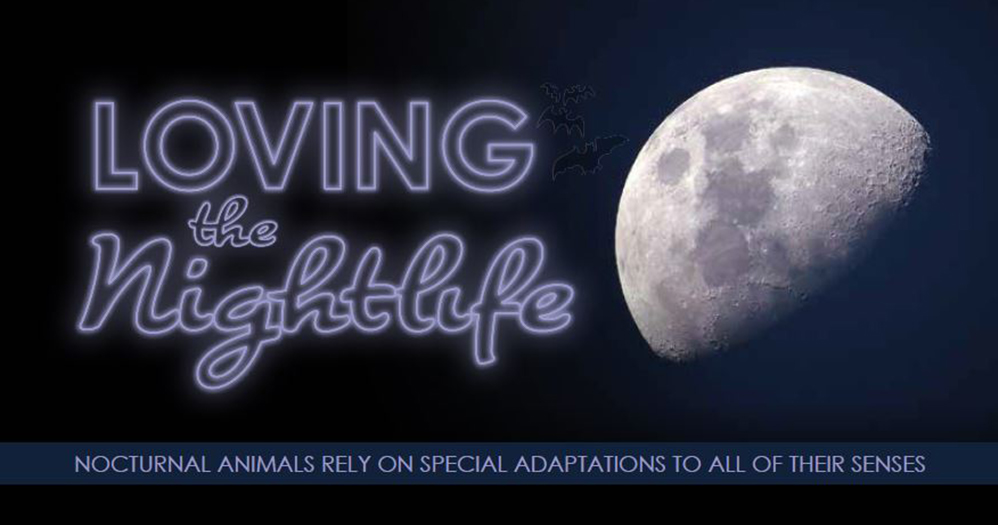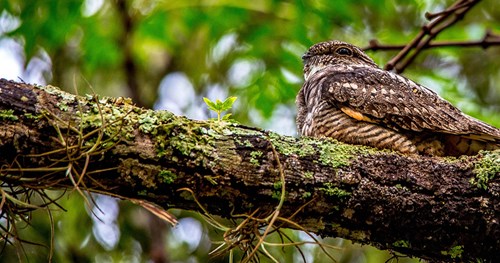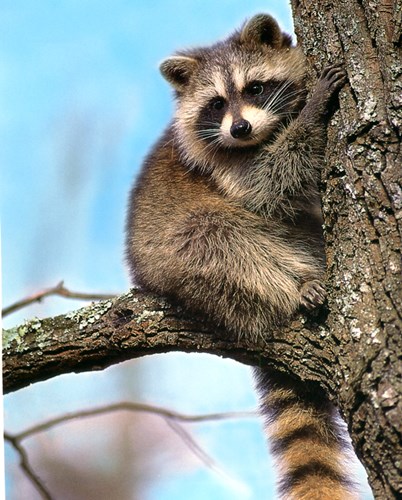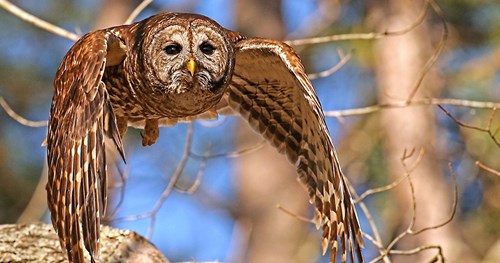Loving the Nightlife
10/17/2018 2:19:52 PM
From MDWFP

Night owls, early birds, up with the larks…we have all kinds of expressions about our sleep habits (or lack thereof). It should not surprise us that scientists have their language for describing how animals go about their days and nights. No matter what time it is, there is likely to be some type of creature active nearby.
Scientists use four categories to describe an animal’s normal active times, with the most familiar ones being diurnal and nocturnal. Diurnal creatures are active mainly during daylight hours, while nocturnal creatures are active mostly at night. The other two are crepuscular and cathemeral. Crepuscular animals are generally active at dusk or dawn while cathemeral species have no set time when they are most active. Cathemeral animals go about their lives no matter what time of the day or night, spreading their activity equally throughout each 24-hour period.
Being mostly diurnal animals ourselves, we humans are familiar with the other day-dwellers around us. It might seem odd that there is such variety when animals are awake and moving, but there are many advantages to being active at different times. Imagine that you are an owl, hunting in a field for mice. If you tried to hunt during the day, you would face competition from other birds of prey like hawks and falcons. But at night, you have the whole field to yourself.

Conversely, if you are a prey animal like the mouse, you might have a dozen predators that are active during the day (hawks, falcons, snakes, and more). But there are fewer species that specialize in night hunting. Sometimes this works to the hunters’ favor, though, if they can use the cover of darkness to sneak up on a diurnal animal when it is sleeping.
So if being nocturnal means less competition for food, fewer predators, and ease of sneaking up on prey, then why isn’t every critter nocturnal? It takes some special adaptations to be able to make it as a nocturnal species. The biggest concern, naturally, is the lack of light. So how do all of these animals survive and thrive in the dark?
The answer is that most nocturnal species have special adaptations to their senses, usually vision, hearing, and smell. Some animals use their sense of touch as well, and taste generally is left out of the equation. Few creatures navigate their world by licking things.
Nocturnal animals only have starlight and varying levels of moonlight to help them see at night. Because of this, nocturnal animals’ eyes are structured differently from diurnal animals in three ways. First, nocturnal animals generally have much larger eyes than their daytime counterparts. Having bigger eyes and wider pupils means that the eyes can open wide enough to take in every bit of light available.
Second, nocturnal animals have a different balance of vision cells in their eyes. If you are familiar with rods and cones from high school biology class, then you know that each of those cell types serves a different purpose. Cones assist with color vision—diurnal animals tend to have a lot of those. Rods specialize in sensing light—nocturnal animals have significantly more of them than their daytime counterparts. A lot of rods help to take advantage of even a small amount of light.

Third, nocturnal (and sometimes crepuscular) animals have a special layer in their eye called the tapetum lucidum, which is a layer of cells that is reflective and bounces the light back and forth within the eye. If you have ever seen the shine of an animal’s eyes at night, you are seeing the tapetum lucidum reflecting the light of a car’s headlights or a flashlight. This special layer helps the rod cells catch even more light.
Many Mississippi animals have great night vision—you might immediately think of owls or raccoons. One fascinating group is the nightjars. These small birds are more commonly heard than seen. Their eyesight is so well adapted to the darkness that they are rarely seen during the day. Their calls are easy to identify (several species are even named after their calls like the Whippoorwill and the Chuck-will’s-widow). The third Mississippi nightjar species is the Common Nighthawk. All three species spend their evenings hunting for insects, which they catch in midair.
While improved night vision certainly helps nocturnal animals get around in the dark, it is even more advantageous to have multiple improved senses. In many species, this means improved hearing as well. Nocturnal animals use hearing for multiple purposes, including tracking down their prey. Others use sound to communicate and find each other when vision might not be as helpful.
The best example of Mississippi animals that use their hearing to hunt is the bat. Mississippi has 15 bat species, and all of them specialize in hunting by sound. Bats use their incredible hearing to locate their prey using echolocation. The bat squeaks and then listens for the tiny echoes of sound bouncing off of its surroundings. A bat’s echolocation is so sensitive that it even can find mosquitos this way.
During certain times of year it is vital for animals to be able to find each other, like breeding season. For frogs and toads, it is difficult to see a mate in the dark. They solve this issue by forgetting looks and focusing on sounds.
If you have ever stood near a pond or marsh on a summer evening, you have heard the sounds of amphibian romance. As the sun sets, male frogs and toads begin to sing (or croak, ribbit, honk, and chirp) hoping to attract a female. With all that noise, how on earth does a female frog figure out which male is even her species? The answer is in the call. Every species of frog or toad has a unique song, and females know which tune to choose. Female frogs and toads also have larger ears than the males to hear their suitors better.

Some nocturnal species seem to ignore hearing and vision and rely on their sense of smell to navigate their nocturnal world. Moths are a great example of this. There are many species of moths in Mississippi. Though most are active at night, there are a few like the hummingbird moth that can be seen visiting flowers in the daytime.
Most adult moths drink nectar from flowers, just like their daytime relatives the butterflies. Rather than relying on bright colors to find their flowers, moths can track their meals by smell. Moths use their sensitive antennae to pick up the chemicals that make up scents. There are even flowers that specialize in producing strong scents at night just to attract moths.
For some adult moths, life is more complicated. Moths in the Saturniidae family, like the beautiful green Luna Moth, do not have mouths as adults. Instead of eating, they spend their short adult life seeking a mate. In just a week or so, adult Luna Moths must find a partner, mate, and lay their eggs to ensure the next generation. To accomplish this feat, the female moths produce special pheromones—you can think of this as an attractive perfume. Male moths can smell these pheromones a mile away.
These are just a few of the state’s nighttime specialists, but the “In the Dark” exhibit at the Mississippi Department of Wildlife, Fisheries, and Parks’ Mississippi Museum of Natural Science will allow guests to experience mysteries of the night through digital interactives, dioramas, and lifelike models of the night from all over the world and through history. The exhibit begins September 29 and ends December 31.
Whether nocturnal animals use sight, sound, or smell to get around in the dark, they are all impressive creatures.
Jean Aycock is an Outreach Educator for MDWFP’s Mississippi Museum of Natural Science



